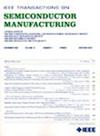A Proactive Approach of Optimizing Real-Time Equipment Monitoring Settings for Enhancing End-of-Line Yield
IF 2.3
3区 工程技术
Q2 ENGINEERING, ELECTRICAL & ELECTRONIC
引用次数: 0
Abstract
In semiconductor manufacturing, wafer acceptance test (WAT) data consists of end-of-line (EOL) electrical parameters reflecting product quality and process capability, while in-line equipment plays a crucial role in shaping these outcomes. Engineers collect real-time monitoring (RTM) data that are used for reactive diagnosis when WAT detects issues. It is highly desirable to have quantitative prediction models linking RTM data to EOL parameters, so that RTM control region settings can be proactively optimized to keep WAT results on target with low variations, ultimately enhancing EOL yield. This paper designs WAPOR, a framework for EOL parameter prediction exploiting significant RTM items and their monitoring setting optimization, to proactively reduce resultant WAT variations. There are three innovations: (i) Key RTM Item Identification (H-RIS) for individual EOL parameters by combining three machine learning methods for both linear and non-linear analysis; (ii) WAT Parameter Prediction Model (WPBM) learned from applying Deep Back-Propagation Neural Networks (DBPN) to multi-dimensional, non-linear prediction of an EOL parameter value based on its key RTM items; and (iii) equipment monitoring control setting optimization (RRS-GA) to make WAT on target with low variation. As such, WAPOR moves beyond traditional linear approaches, uncovers complex relationships and empowers engineers to set RTM parameters proactively to make WAT forecast fall within WAT specification and minimize its variance. Simulation results demonstrate that WAPOR maintains WAT target alignment within 2% of the target while reducing variation by 49%. WAPOR has a good potential to improve process capability and EOL yield.一种优化实时设备监控设置以提高产率的主动方法
在半导体制造业中,晶圆验收测试(WAT)数据由反映产品质量和工艺能力的线端(EOL)电气参数组成,而在线设备在形成这些结果方面起着至关重要的作用。工程师收集实时监控(RTM)数据,用于在WAT检测到问题时进行反应性诊断。迫切需要建立定量预测模型,将RTM数据与EOL参数联系起来,以便主动优化RTM控制区设置,使WAT结果在低变化的情况下保持在目标范围内,最终提高EOL产量。WAPOR是一个利用重要RTM项目及其监测设置优化的EOL参数预测框架,旨在主动减少由此产生的WAT变化。有三个创新:(i)结合线性和非线性分析的三种机器学习方法,对单个EOL参数进行关键RTM项目识别(H-RIS);(ii) WAT参数预测模型(WPBM)通过应用深度反向传播神经网络(DBPN)对EOL参数值进行基于关键RTM项的多维非线性预测而得到;(iii)设备监控控制设置优化(RRS-GA),使WAT在低变化的情况下达到目标。因此,WAPOR超越了传统的线性方法,揭示了复杂的关系,并授权工程师主动设置RTM参数,使WAT预测符合WAT规范,并将其方差最小化。仿真结果表明,WAPOR将WAT目标对准度保持在目标的2%以内,同时减少了49%的偏差。WAPOR在提高工艺性能和EOL收率方面具有良好的潜力。
本文章由计算机程序翻译,如有差异,请以英文原文为准。
求助全文
约1分钟内获得全文
求助全文
来源期刊

IEEE Transactions on Semiconductor Manufacturing
工程技术-工程:电子与电气
CiteScore
5.20
自引率
11.10%
发文量
101
审稿时长
3.3 months
期刊介绍:
The IEEE Transactions on Semiconductor Manufacturing addresses the challenging problems of manufacturing complex microelectronic components, especially very large scale integrated circuits (VLSI). Manufacturing these products requires precision micropatterning, precise control of materials properties, ultraclean work environments, and complex interactions of chemical, physical, electrical and mechanical processes.
 求助内容:
求助内容: 应助结果提醒方式:
应助结果提醒方式:


